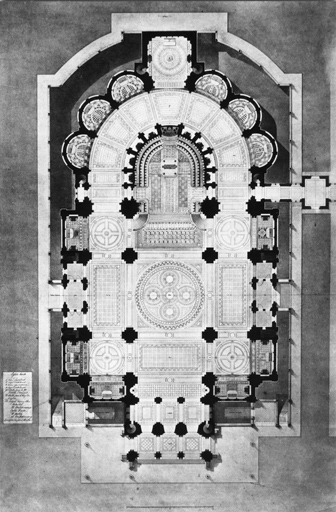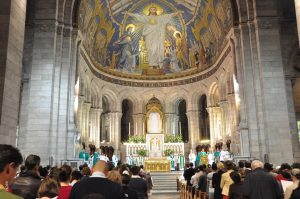 Sitting atop the highest hill in Paris (Montmarte), the Basilica of Sacré-Cœur is the second highest structure in Paris – second only to the famous Eiffel Tower. Built between 1875 and 1914 and designed by Paul Abadie (the winner of a design competition with 78 entries) and six successive architects, it was dedicated to the Sacred Heart of Jesus, as a sign of penitence, trust, hope and faith. The exterior cladding is travertine stone, known as ‘Château-Landon’, that comes from the Souppes-sur-Loing quarry in Seine et Marne. This travertine is unique because it is extremely hard with a fine grain and exudes calcite on contact with rainwater, giving the basilica it’s unique bright white color. While the building is certainly beautiful, what I found most interesting is that it has been used as a place of perpetual adoration of the Blessed Sacrament continuously since August 1, 1885 – 29 years before it was even completed! Since that day, pilgrims from around the world have come to pray silently before the reserved Sacrament. The Benedictine Sisters of the Sacré-Cœur de Montmartre make sure that not a single moment of the continuous relay of prayer is interrupted.
Sitting atop the highest hill in Paris (Montmarte), the Basilica of Sacré-Cœur is the second highest structure in Paris – second only to the famous Eiffel Tower. Built between 1875 and 1914 and designed by Paul Abadie (the winner of a design competition with 78 entries) and six successive architects, it was dedicated to the Sacred Heart of Jesus, as a sign of penitence, trust, hope and faith. The exterior cladding is travertine stone, known as ‘Château-Landon’, that comes from the Souppes-sur-Loing quarry in Seine et Marne. This travertine is unique because it is extremely hard with a fine grain and exudes calcite on contact with rainwater, giving the basilica it’s unique bright white color. While the building is certainly beautiful, what I found most interesting is that it has been used as a place of perpetual adoration of the Blessed Sacrament continuously since August 1, 1885 – 29 years before it was even completed! Since that day, pilgrims from around the world have come to pray silently before the reserved Sacrament. The Benedictine Sisters of the Sacré-Cœur de Montmartre make sure that not a single moment of the continuous relay of prayer is interrupted.
My wife and I had the pleasure of participating in Sunday worship at the basilica. While there was a constant flow of tourists around the perimeter of the worship space, the size of the space (115′ wide x 279′ long) kept us quite isolated from them. I would estimate that we were seated approximately 80′ from the altar, which is elevated about ten steps. The seating area was full of worshipers and it was a unique experience to worship with such a large assembly. While it was difficult to hear and understand the homily because of the long reverberation times and the background noise of hundreds of tourists shuffling around the building, the sense of enclosure provided by the 52′ diameter, 180′ high dome actually created a feeling of unity among the worshipers. While the elevated altar with tabernacle behind seemed very appropriate for a place of adoration, it created quite a psychological barrier between the assembly and the liturgical action. Even though the priest was facing us, it was still a rather pre-Conciliar experience. For those sitting outside the domed area, separated by huge pillars and immediately adjacent to the stream of tourists, I cannot imagine that it was a particularly good liturgical experience. But keeping in mind that this church is very much a place of pilgrimage, the design and arrangement seems to be appropriate to that use.

Paul Abadie ; projet pour le concours de 1874 pour l’église du Vœu national au Sacré-Cœur à Paris, plan. (Archives de la basilique du Sacré-Cœur de Montmartre). Phot. Claude Laroche.
The service ended with a long announcement listing all the coming events for the next two months. Most surprising was the last announcement in French, English, Italian and Spanish, inviting everyone at Mass to a luncheon after Mass. Unfortunately, our schedule did not permit us to attend but it would have been most interesting to see how many Mass attendees took them up on the offer and how they fed them all!
(Photography is not permitted within the basilica but the basilica has provided the interior image for public use.)


1 Trackback